Director Dean DeBlois On The Evolution Of The 'How To Train Your Dragon' Trilogy And His Plans To Go Live-Action Next [Interview]
A couple of weeks back, I was able to visit the DreamWorks Animation campus in Glendale California, an oasis hidden amongst the Los Angeles concrete. There, I had a chance to visit Dean DeBlois' new office and talk to the filmmaker about How to Train Your Dragon: The Hidden World. As you may know, DeBlois wrote and directed the modern Disney Animation classic Lilo & Stitch with Chris Sanders, before moving to DreamWorks to direct all three installments of the now completed How to Train Your Dragon trilogy.
In our interview, we talk about the evolution of the story from the beginning of the trilogy to the conclusion, comparisons to Star Wars, the trouble with sequels, an animation franchise where the characters physically grow and age, the original idea for the second movie that was abandoned, how he feels about making audiences cry, what it was like to work with Guillermo Del Toro and Drew Struzan, his hopes to make a live-action film next, a possible Dragons theme park ride, and the challenge of making a mythical based franchise in the age of Avatar.
Note: the image below is a drawing of Dean created by Nico Marlet, the trilogy's principal character designer. You can also listen to the interview above in podcast form thanks to /Film Daily.Peter: First of all, I love the movie.Dean: Thank you.Peter: Yeah. It's really a beautiful conclusion to this franchise. Dean: Awesome. Great. I'm glad you think so.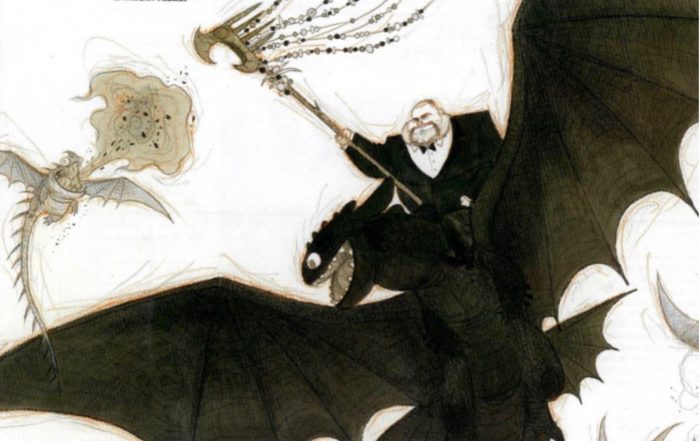 Peter: How much of the Dragon Trilogy was mapped out at the beginning? Dean: So if we're talking about the first film, Chris Sanders and I jumped onto that at really late in the game. Like we had 15 months before its release in theaters, so and they wanted kind of a reworking of the story from the start. So that was a very kind of intense and focused effort to get a movie that worked up on screen. And there was no thought of sequels or franchise or anything. Not until the movie went out there and actually performed for the studio.
Peter: How much of the Dragon Trilogy was mapped out at the beginning? Dean: So if we're talking about the first film, Chris Sanders and I jumped onto that at really late in the game. Like we had 15 months before its release in theaters, so and they wanted kind of a reworking of the story from the start. So that was a very kind of intense and focused effort to get a movie that worked up on screen. And there was no thought of sequels or franchise or anything. Not until the movie went out there and actually performed for the studio.
Chris had gone back to working on The Croods at that point. And I was tasked with coming up with ideas for a sequel. And due to my general allergy to sequels, I said, what if we did a trilogy? 'Cause that we could do three acts of one story. We could draw upon some unanswered questions in the first movie. But tell the story of this Viking runt ne'er-do-well to the wise, selfless Viking Chief that he was destined to be. Loosely inspired by his arc in the books.
So that we could get to that moment like the opening narration of Cressida Cowell's first book. There were dragons when I was a boy. I thought there was something really emotional about that. But it suggests the end of an era. The disappearance of dragons and all of the mystery and emotion attached to that idea. So yeah, at that point [we were] talking about it in three acts. That the only condition that I was given by Jeffrey Katzenberg at the time was that every one of the installments had to stand alone. It wasn't reliant upon the previous film. And we couldn't have cliffhangers. They had to work independently and together.
Peter: Even though you say that, I feel like the second one has a very like Empire Strikes Back feel to it.Dean: Well that's a huge compliment. Thank you. That was certainly an inspiration in tone.Peter: Yeah. So when starting this film, were you working back from the ending of "we need to find out why the dragons disappeared?"Dean: Yes. Exactly. Like if Hiccup does become the seasoned, wise Chief, how could his ascension into that role be accompanied by the disappearance of dragons? And furthermore, could it be his decision? What would have led to that? For a guy that's all about pounding this idea of coexistence into his own people and anyone who will listen, how does that guy go to embrace this idea of separating?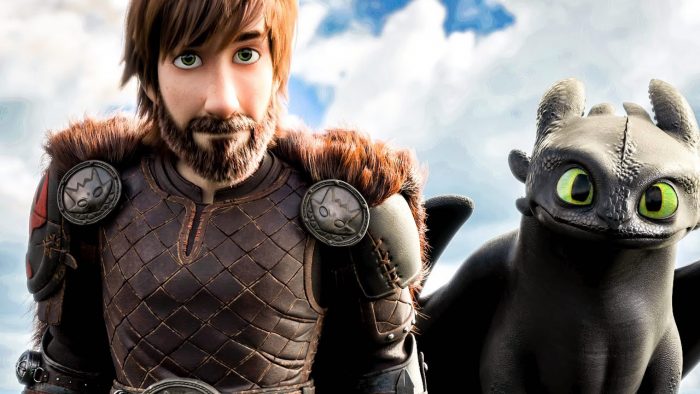 Peter: Yeah. It's also very interesting that in the medium of animation, usually with franchises, you don't get to see the characters grow up over time. Like, sure you get to see Andy in Toy Story, but the main characters–Dean: I think that's the only example. Yeah. I can't think of any other characters that have grown up on screen.Peter: Especially TV. Like Simpsons are the same as they always were, a little bit different style, but...Dean: Yeah. It's almost an animated convention that you can live timelessly in this world. As sequels and TV series develop. Characters never even change clothes, never mind ages.Peter: Yeah. So why did you decide to take them in this direction, or leave them off where you do? Is it like...?Dean: It was a practical consideration, because at its core ,for a story to be worth telling, you need a character who has to undergo some sort of transformation. And if you look at Hiccup in the first movie he, by the end of it, he gained everything he was after. He has his father's love, the admiration of the town, the attention of Astrid, the coolest dragon. He ends a age-old war. Like this is a character without a problem. Peter: That's the problem of all movies that have sequels, right?Dean: Yeah. 'Cause then it becomes a very sort of surface level issue. Like somebody stole my car. And that becomes the next sort of pointless adventure with the same five or six characters. I wanted to avoid that. So I thought by advancing the clock and re-meeting Hiccup at a point where he's facing another universal problem, one that we're all gonna have to go through this transition from youth and carefree abandon into adulthood with consequence. The search for identity with two overbearing parents. That felt to me like something that a lot of people could relate to and it was an inner problem as much as it was an external one.Peter: One of the most interesting things to me...[Peter finally looks around and notices all the cool things in Dean's office]Peter: By the way, this is an awesome office. Dean: Thanks.Peter: Is this your office?Dean: Yeah. Literally moved in two days ago. We got kicked out of our production area up on the fifth floor of that other building.[Peter notices some old school Kenner Star Wars ships still in their original box, from Empire Strikes Back]Peter: You got old school Star Wars toys.Dean: Yet to be unpacked.
Peter: Yeah. It's also very interesting that in the medium of animation, usually with franchises, you don't get to see the characters grow up over time. Like, sure you get to see Andy in Toy Story, but the main characters–Dean: I think that's the only example. Yeah. I can't think of any other characters that have grown up on screen.Peter: Especially TV. Like Simpsons are the same as they always were, a little bit different style, but...Dean: Yeah. It's almost an animated convention that you can live timelessly in this world. As sequels and TV series develop. Characters never even change clothes, never mind ages.Peter: Yeah. So why did you decide to take them in this direction, or leave them off where you do? Is it like...?Dean: It was a practical consideration, because at its core ,for a story to be worth telling, you need a character who has to undergo some sort of transformation. And if you look at Hiccup in the first movie he, by the end of it, he gained everything he was after. He has his father's love, the admiration of the town, the attention of Astrid, the coolest dragon. He ends a age-old war. Like this is a character without a problem. Peter: That's the problem of all movies that have sequels, right?Dean: Yeah. 'Cause then it becomes a very sort of surface level issue. Like somebody stole my car. And that becomes the next sort of pointless adventure with the same five or six characters. I wanted to avoid that. So I thought by advancing the clock and re-meeting Hiccup at a point where he's facing another universal problem, one that we're all gonna have to go through this transition from youth and carefree abandon into adulthood with consequence. The search for identity with two overbearing parents. That felt to me like something that a lot of people could relate to and it was an inner problem as much as it was an external one.Peter: One of the most interesting things to me...[Peter finally looks around and notices all the cool things in Dean's office]Peter: By the way, this is an awesome office. Dean: Thanks.Peter: Is this your office?Dean: Yeah. Literally moved in two days ago. We got kicked out of our production area up on the fifth floor of that other building.[Peter notices some old school Kenner Star Wars ships still in their original box, from Empire Strikes Back]Peter: You got old school Star Wars toys.Dean: Yet to be unpacked.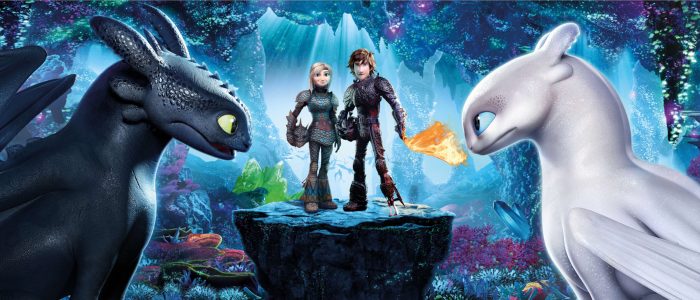 Peter: Yeah. Empire Strikes Back right there. One of the most interesting things about animation I think is the development process is so long and especially you hear these stories, how things have changed over time. So I'm wondering, how did this film change from the original idea that you had for it when you started developing this third film in the franchise to what it is now?Dean: Well, if we go back to the second movie, Valka was originally meant to be the sympathetic antagonist of that movie. In other words, Hiccup met her in the same way that he did and was amazed by her to find out there's another dragon rider who's even more steeped in the world of dragons. But her fundamental core belief was that humans could not be trusted and that dragons needed to be protected from them. And that ran against Hiccup's desire to teach people to get along with dragons.
Peter: Yeah. Empire Strikes Back right there. One of the most interesting things about animation I think is the development process is so long and especially you hear these stories, how things have changed over time. So I'm wondering, how did this film change from the original idea that you had for it when you started developing this third film in the franchise to what it is now?Dean: Well, if we go back to the second movie, Valka was originally meant to be the sympathetic antagonist of that movie. In other words, Hiccup met her in the same way that he did and was amazed by her to find out there's another dragon rider who's even more steeped in the world of dragons. But her fundamental core belief was that humans could not be trusted and that dragons needed to be protected from them. And that ran against Hiccup's desire to teach people to get along with dragons.
So toward the end of the original version of the second movie, she flew to Berk to extract the dragons to get them to safety. Because this unknown force to be reckoned with, Drago Bludvist, was coming. But he really wasn't going to be a strong presence until the third movie. And it was Hiccup fighting his own mother to protect his way of life on Berk. And she leaves defeated but convinced that he will have to make a decision.
And that was to set up her return in the third movie in the third act when Drago did come crashing upon the shores of Berk with all of his might. She flew back in as having thought about it and been converted to his way of thinking. She flew back in to be his strongest ally with her army of dragons. So that was fundamentally changed because really it was just the relationship of the mother was going to be problematic like with our audience in having young kids turning to their Moms and say, why is his mother fighting him? Why is she taking away the dragons?
So that arc was collapsed. It means that Drago came into the second movie in kind of a one-dimensional way. 'Cause he was just this brute. But the ambition originally was actually to have Drago arc in the third movie. He was going to have survived the defeat at the end of the second movie and find himself marooned on an island in a pile of wreckage with home to a very aggressive, territorial dragon that wanted to see him dead.
And so once Drago realized that he had been succeeded in his own armada by this character named Grimmel, he was determined to get back there and reassert his position. The only way off the island was to befriend that dragon. And so it was this kind of headstrong tit-for-tat trying to figure out this how to earn the respect and trust with this dragon. And in doing so he develops this kind of this affection for it. So that when he finally flew into the third act battle, he lands on the side of the Dragon Riders. And ends up showing some steps toward redemption.
It was just a story that was gonna require far too much care and feeding and time in order to do it right. And we knew that we had to focus on Hiccup and the new element of Toothless and his call of the wild that it was unfortunately just an element that had to be lopped off.
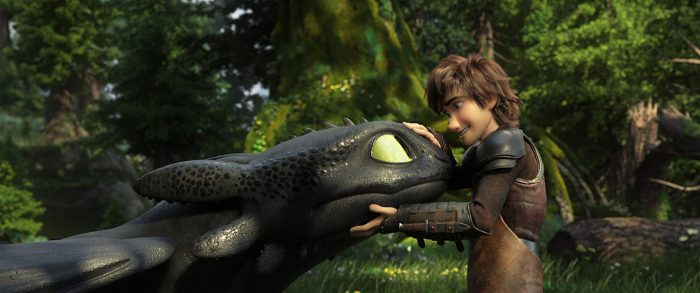 Peter: Do you feel bad making everyone cry? Dean: No. For me it's a victory. Yeah. In fact, my kind of my pet peeve is when people say to me, oh I was so moved I almost cried. 'Cause I actually I feel like a personal pang of defeat in that statement. It's like saying you almost succeeded. So if someone cries I feel great. That was the intention that we want. We want to create a roller coaster of emotion and move people to laughter and tears. So if we get the tears, I'm especially proud.Peter: Yeah. Well, you got my tears.Dean: Thank you.
Peter: Do you feel bad making everyone cry? Dean: No. For me it's a victory. Yeah. In fact, my kind of my pet peeve is when people say to me, oh I was so moved I almost cried. 'Cause I actually I feel like a personal pang of defeat in that statement. It's like saying you almost succeeded. So if someone cries I feel great. That was the intention that we want. We want to create a roller coaster of emotion and move people to laughter and tears. So if we get the tears, I'm especially proud.Peter: Yeah. Well, you got my tears.Dean: Thank you.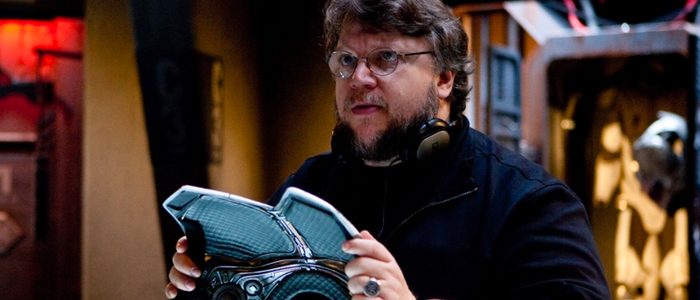 Peter: Is Guillermo del Toro still consulting with the features here?Dean: I haven't seen him around. I think he does have a consulting deal. But the last time I saw Guillermo was a few years back. I mean, in relation to DreamWorks. I went to go meet him at Bleak House and he had read an early script for this movie and he was, he's always very generous with his time and he was just talking, he actually inspired me to just get a little more connected with my inner fanboy. And he said, he pointed out, this is such a rare opportunity to get to do a trilogy. And he said, just go for it. Put everything up on screen that you've ever wanted to see. Don't be so slavish to the continuity.
Peter: Is Guillermo del Toro still consulting with the features here?Dean: I haven't seen him around. I think he does have a consulting deal. But the last time I saw Guillermo was a few years back. I mean, in relation to DreamWorks. I went to go meet him at Bleak House and he had read an early script for this movie and he was, he's always very generous with his time and he was just talking, he actually inspired me to just get a little more connected with my inner fanboy. And he said, he pointed out, this is such a rare opportunity to get to do a trilogy. And he said, just go for it. Put everything up on screen that you've ever wanted to see. Don't be so slavish to the continuity.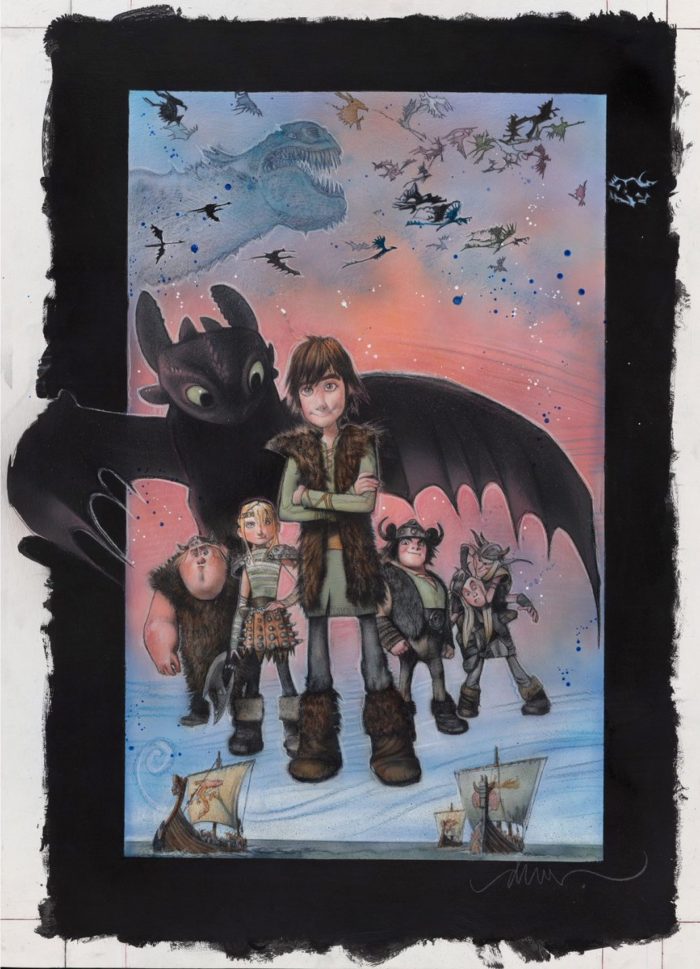 Peter: What's the story behind the Drew Struzan posters? Because there was one at Comic-Con, the last one. And then there's some that were put online, but we don't even know where those are going.Dean: Yeah. Yeah, yeah, I was talking to him about this last night. He was at our crew party. Well, I approached Drew back on Dragon 2, telling him I would love him to do a poster for us. And we got the okay from the marketing department to come up with the money for it. But then he got sick. So he had, he did a couple of rough comps. And one of them he just gave to me and that's the one we reproduced and gave to fans at Comic-Con that year. And then he recovered and happily started in doing his own work and happy in his retirement. But I invited him to see a screening of the movie here himself. And Dylan, his wife. And they really responded strongly and cried. And I said, I would love it, it's my dream if you'd ever consider doing a triptych for us. And he agreed to do it. He came out of retirement and he painted these incredible posters. They're full size and they're glorious.Peter: Oh, wow.Dean: And yeah, there's a little tease on Fandango, but we're still figuring out at what point we're going to print them up nice and big and on high-quality stock and make them available to fans.Peter: Yeah. I definitely want those. What is next for you? I mean, this has been a long... This has been like almost 10 years of your life, right? Dean: It has been, yeah, 10 years. 10 years. It's the end of a decade and I'm really proud of it, but I'm also eager to get back to other projects that have been sitting on the back burner. And hopefully, do something live action at some point.Peter: Oh live action, 'cause you've done some music video stuff, right?Dean: Yeah. And I sold three movies to write and direct back in the years between Lilo and Stitch and jumping on to How to Train Your Dragon. And–Peter: Are you talking about Banshee and Lighthouse?Dean: Yeah. Lighthouse and Sightings. And those were movies that got stalled due to changes in the presidency at studios. So I would love to pick up where we left off on a couple of those and bring them to fruition. Or jump onto something that I feel a connection with that somebody's making. It's all wide open. First I just wanna take a little vacation, clear my head.Peter: I understand that. But those three are live action?Dean: Yes. All three of those are.Peter: Oh, very cool. And the other thing I wanted to ask you. This series has such fantastic world building. When are we gonna get like a theme park ride where we can...?Dean: Oh... that's the dream, right? I remember back on Mulan, Chris Sanders and I joking that if we ever made it to like a Disney-like Ice Capades special that that would be like true success. Like we made it to an ice show. But yeah, now in this world, to be like a Harry Potter-esque theme park attraction would be amazing. Who knows?Peter: It makes sense to. I remember being in the theater for the first film and I think flying has never felt more real in a movie. Like feeling the feeling of flight.Dean: Well that's great. Yeah, I mean, we definitely tried to make it feel as visceral as we could within the confines of a movie theater. But I agree with you in a virtual like kind of proper ride format that would be really impressive.Peter: Plus, it would be cool just to visit the world.Dean: I totally agree. Go talk to somebody. Tell them you want it.
Peter: What's the story behind the Drew Struzan posters? Because there was one at Comic-Con, the last one. And then there's some that were put online, but we don't even know where those are going.Dean: Yeah. Yeah, yeah, I was talking to him about this last night. He was at our crew party. Well, I approached Drew back on Dragon 2, telling him I would love him to do a poster for us. And we got the okay from the marketing department to come up with the money for it. But then he got sick. So he had, he did a couple of rough comps. And one of them he just gave to me and that's the one we reproduced and gave to fans at Comic-Con that year. And then he recovered and happily started in doing his own work and happy in his retirement. But I invited him to see a screening of the movie here himself. And Dylan, his wife. And they really responded strongly and cried. And I said, I would love it, it's my dream if you'd ever consider doing a triptych for us. And he agreed to do it. He came out of retirement and he painted these incredible posters. They're full size and they're glorious.Peter: Oh, wow.Dean: And yeah, there's a little tease on Fandango, but we're still figuring out at what point we're going to print them up nice and big and on high-quality stock and make them available to fans.Peter: Yeah. I definitely want those. What is next for you? I mean, this has been a long... This has been like almost 10 years of your life, right? Dean: It has been, yeah, 10 years. 10 years. It's the end of a decade and I'm really proud of it, but I'm also eager to get back to other projects that have been sitting on the back burner. And hopefully, do something live action at some point.Peter: Oh live action, 'cause you've done some music video stuff, right?Dean: Yeah. And I sold three movies to write and direct back in the years between Lilo and Stitch and jumping on to How to Train Your Dragon. And–Peter: Are you talking about Banshee and Lighthouse?Dean: Yeah. Lighthouse and Sightings. And those were movies that got stalled due to changes in the presidency at studios. So I would love to pick up where we left off on a couple of those and bring them to fruition. Or jump onto something that I feel a connection with that somebody's making. It's all wide open. First I just wanna take a little vacation, clear my head.Peter: I understand that. But those three are live action?Dean: Yes. All three of those are.Peter: Oh, very cool. And the other thing I wanted to ask you. This series has such fantastic world building. When are we gonna get like a theme park ride where we can...?Dean: Oh... that's the dream, right? I remember back on Mulan, Chris Sanders and I joking that if we ever made it to like a Disney-like Ice Capades special that that would be like true success. Like we made it to an ice show. But yeah, now in this world, to be like a Harry Potter-esque theme park attraction would be amazing. Who knows?Peter: It makes sense to. I remember being in the theater for the first film and I think flying has never felt more real in a movie. Like feeling the feeling of flight.Dean: Well that's great. Yeah, I mean, we definitely tried to make it feel as visceral as we could within the confines of a movie theater. But I agree with you in a virtual like kind of proper ride format that would be really impressive.Peter: Plus, it would be cool just to visit the world.Dean: I totally agree. Go talk to somebody. Tell them you want it.![]() Peter: Avatar came out like a year before your first film came out. They announced five films and in that time, you've made a trilogy. But I'm just wondering how did Avatar influence or not influence the series because there is some crossover with dragons, mythical elements and bioluminescence. Dean: Well, I remember seeing the first trailers come out and we saw the Banshees flying around. And we thought oh now we're gonna look like we copied them. But we'd been at it for, we'd been working on the movie for 15 months and we were wrapping up as they were releasing. So we knew we had our flight sequences and we hoped that they would stand apart from all of the excitement that was gathering around Avatar.
Peter: Avatar came out like a year before your first film came out. They announced five films and in that time, you've made a trilogy. But I'm just wondering how did Avatar influence or not influence the series because there is some crossover with dragons, mythical elements and bioluminescence. Dean: Well, I remember seeing the first trailers come out and we saw the Banshees flying around. And we thought oh now we're gonna look like we copied them. But we'd been at it for, we'd been working on the movie for 15 months and we were wrapping up as they were releasing. So we knew we had our flight sequences and we hoped that they would stand apart from all of the excitement that was gathering around Avatar.
And then when it came to designing The Hidden World, we were also really conscious of the fact that Avatar did bioluminescence so well that if we were going to include it, we had to make it feel different and unique unto itself. So in terms of color palette and our use of it within the tunnels that connect these larger spaces, we wanted it to be almost like a black light effect that would actually cause the dragons flying through to reveal their own patterns. And to have when you talk about something that feels magical within our understanding of geology and biology on this planet, there are only certain things like phosphorescence and bioluminescence and crystal caverns that might be carrying light from deeper magma veins that we were talking about like a salty atmosphere because the all that water spilling in and interacting with lava would create a steamy atmosphere in which coral could actually grow midair.
And these were all things that we were trying to make our own to do a version of a world that didn't feel like an Avatar rip-off. So hopefully that's not the immediate instinct. But I could see if because it's such a strong, iconic imprint of Pandora that people might kind of make that connection.
Peter: Well thank you very much.Dean: Thank you.
